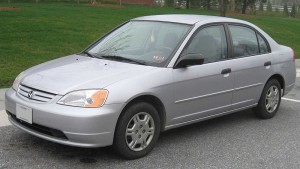
The Honda Civic may cost more, unfairly so, to insure if you live in the inner city, according to the CFA.
This story has been updated to include a response to the CFA study by an insurance industry trade group.
Millions of low- and moderate-income American motorists, especially those with lower education levels and living in inner cities, are being unfairly penalized with high insurance rates, even if they have steady jobs and clean driving records, contends the Consumer Federation of America.
In a survey of 15 cities and surrounding suburbs, these motorists routinely were required to pay at least $900 for collision and comprehensive coverage, with 50% being hit with bills of more $1,500, according to a new CFA study that checked rates for a 30-year-old female bank teller with 10 years driving experience and no collisions or tickets on her record, owning a 2004 Honda Civic.
“The price can easily double or triple” for a person of moderate means and lower education, said J. Robert Hunter, the consumer group’s Director of Insurance and a former Texas Insurance Commissioner.
And insurance premium penalties compound when an otherwise seemingly low-risk driver doesn’t own a home or has a less than stellar credit record, CFA officials stressed. In many cases, such motorists wind up paying more for basic levels of coverage than they do for fuel or even for the cost of a car loan. That can make it difficult for some to purchase a vehicle.
“High auto insurance premiums represent a huge barrier to car ownership, and economic opportunity, for millions of lower-income Americans,” said Stephen Brobeck, CFA’s Executive Director.
The non-profit organization noted that not all insurance companies follow what was described as “discriminatory” practices. USAA, which is geared to military personnel, does not use such measures when determining premiums. And State Farm tends to downplay such factors when calculating rates.
But low-income and poorly educated motorists tend to be hit by high penalties from some other major insurers, notably GEICO and Progressive, according to the CFA study.
(Millenials want wheels after all! For more, Click Here.)
Motorists “clearly need relief,” said CFA Executive Director Brobeck. He pointed to California as an example of how insurance rules should be revised. The state does not permit factors such as education or income to be considered when setting rates.
(Click Here for details about why automakers are sitting out the Super Bowl this year.)
Asked why rates run so high, Hunter suggested many insurance companies don’t want to carry lower-income, inner-city customers. They prefer to handle higher-income suburbanites who may have multiple, high-price vehicles to insure.
(To see more about why Toyota could lose the sales lead to VW this year, Click Here.)
Ironically, discriminatory insurance practices impact even those affluent suburbanites, CFA officials noted. All too often, motorists on a tight budget will drive without insurance, or may lapse in paying premiums. That can create serious problems if they are in a crash. And in most states, even well-off drivers wind up paying additional fees to compensate for uninsured drivers.
What is a fair price for insurance? The CFA asked ORC International to ask a representative sample of Americans what they thought that 30-year old woman driver should be paying. Four-fifths of the respondents said annual coverage should be less than $750, and half thought the fair amount would be no more than $500.
The CFA study is generating some controversy. The Property Casualty Insurers Association of America agreed that “consumers should shop around for the right coverage,” but the insurance trade organization also argued that the CFA’s proposals “could cause unfair subsidies and break the critical link between risk and pricing.” The result, it concluded, would be an “overall” increase in insurance premiums.

I definitely agrre with the statement about GEICO; tried to get insurance with them many, many years ago and was given nothing but the run-around when trying to obtain an honest quote. Once I finally did the premium was twice as much as the current insurer I had, which was expensive. And some of their rating practices were very suspect. Example, insurers normally check the last 3 years of your driving record for tickets, accidents, claims; a few 5 years. GEICO would go through entire drecord. Everyone I know who had GEICO ended up dropping them rather quickly (or they were dropped if they got a ticket or an accident).
This is not news to many people, it’s reality. The insurance industry has been discriminating against middle and lower income people for decades and it has been proven. The problem is that the insurance industry like many others is able to buy the legislation they desire in DC. They spend plenty of PAC money and they are never prosecuted for the consumer fraud and other crimes.
The U.S. government agencies charged with protecting consumers is broken and has been for decades. As a result many companies routinely defraud consumers be it with unjustifiable insurance rates, defective products or other clearly illegal practices such as failure to honor warranties, refunds, etc.
It’s a disgrace and not a thing is being done about it. The FTC, FCC, SEC, state’s attorney general and many other government agencies have failed the people who pay their salary and who they are sworn to protect.